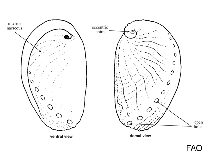Haliotis rubra Leach, 1814
Blacklip abalone| Native range | All suitable habitat | Point map | Year 2050 |

|
| This map was computer-generated and has not yet been reviewed. |
| Haliotis rubra AquaMaps Data sources: GBIF OBIS |
Google image | No image available for this species;
drawing shows typical species in Haliotidae.
Classification / Names Common names | Synonyms | CoL | ITIS | WoRMS
Gastropoda | Lepetellida | Haliotidae
Environment: milieu / climate zone / depth range / distribution range Ecology
Benthic; depth range 0 - 50 m. Temperate, preferred 15°C (Ref. 107945); 32°S - 43°S, 116°E - 153°E
Distribution Countries | FAO areas | Ecosystems | Occurrences | Introductions
Indo-West Pacific: Endemic to Australia, from Fremantle, Western Australia to Angourie, New South Wales and south to Blubber Head, Tasmania.
Length at first maturity / Size / Weight / Age
Maturity: Lm ?, range 3 - 9 cm Max length : 20.0 cm SHW male/unsexed; (Ref. 93239)
Life cycle and mating behavior Maturity | Reproduction | Spawning | Eggs | Fecundity | Larvae
Main reference
References | Coordinator | Collaborators
The Academy of Natural Sciences 2006 OBIS Indo-Pacific Molluscan Database. http://data.acnatsci.org/obis/find_mollusk.html [accessed 21/03/2007]. (Ref. 3204)
IUCN Red List Status
(Ref. 130435: Version 2025-1)
CITES status (Ref. 108899)
CMS (Ref. 116361)
Threat to humans
Human uses
Fisheries: commercial
FAO - Aquaculture: production; Fisheries: landings | FishSource | Sea Around Us
Tools
More information
Max. ages / sizes
Length-weight rel.
Length-length rel.
Length-frequencies
Mass conversion
Abundance
Internet sources
BHL | BOLD Systems | CISTI | DiscoverLife | FAO(Fisheries: ; publication : search) | Fishipedia | GenBank (genome, nucleotide) | GloBI | Gomexsi | Google Books | Google Scholar | Google | PubMed | Tree of Life | Wikipedia (Go, Search) | Zoological Record



